




专制集权的象征 Designs on Power (by Steven Heller, LA Times)
每日一语:
当中国的人们在心理上与物理上击碎了当代世界历史上最大的屠夫罪犯-毛泽东的形象的时候,他们才会开始从专制暴政的阴影中逐渐自由出来,回复正常的人的心态。 --- 陈凯
When the Chinese truly abandon/crush the images of Mao - the biggest mass murderer in human history - psychologically and physically, they can begin to free themselves from despotism and tyranny, they can begin to return to humanity. --- Kai Chen
----------------------------------------------------------
Dear Visitors:
I now paste a very good article from LA Times below for you to read.
Beijing Olympics indeed provides the opportunity for the world to see China as what it truly is: a totalitarian party-state bent to destroy any remnant humanity of any individual in Chinese society. The criminal party-state's biggest weapon in achieving that end is the portrait of their icon - the murderous Mao. They print it on Chinese currency. They erect it on all the public places. They hung it on Tiananmen Gate overlooking everyone....
Smashing Mao's image, both physically and mentally/psychologically, is the prerequisite for the Chinese to free themselves from despotism and tyranny. I hope that one day will come soon when Mao's image is no longer feared/worshipped/revered, but reviled and despised. I am working now with all of you toward achieving that end.
Enjoy the article below now.
Best. Kai Chen 陈凯
Designs on Power
By Steven Heller (LA Times) Sunday August 10, 2008
What a scandal it would be to see Adolf Hitler's portrait hanging in Berlin today or tomorrow. Of course, it could never happen because German law prohibits the public display or celebratory portraits of Der Fuehrer, as well as Nazi signs and symbols like the swastika.
In Russia, hanging portraits of Josef Stalin in public is discouraged (although not unlawful), and since the fall of the Soviet Union, monuments to the brutal dictator have mostly been torn down. In Italy, Benito Mussolini's lock-jawed visage has long been removed from national view, although in his hometown of Predappio a shrine containing his tomb and a souvenir shop replete with Il Duce T-shirts, postcards and bottles of wine annually attracts a fair number of curious tourists.
In China, however, where the Olympic Games opened last week, there are no legal, ethical or moral restrictions against revering Mao Tse-tung, the Great Helmsman, despite the tragic outcome of the Great Leap Forward and the Cultural Revolution, which wreaked havoc on China during the second half of the 20th century and led to the deaths of tens of millions of its people.
Not only is Mao's official depiction, with his Mona Lisa smile, by the painter Zhang Zhenshi still looming over Tiananmen Square, where it has hung since the 1950s, but his face remains on much Chinese currency (although not on the new 10-yuan note created for the Olympics) and on many postage stamps. Although the Olympic logo and graphics are as removed from turgid Chinese socialist realism as can be (and Mao is not to be found anywhere on sanctioned Olympic souvenirs), busts, porcelain figures (Cultural Revolutionary Hummel-ware) produced by Red Guard cadres, posters and other Mao-era souvenirs are plentiful as many flea markets in and around Beijing.
What's more, reproductions of Mao badges and Little Red Books, which were produced in the millions during the Cultural Revolution, as well as Mao clocks, watches and cigarette lighters are available through street vendors and more high-tech websites devoted to such kitsch.
When Germany was defeated in 1945, the Allies declared Nazi graphics to be contraband. But in China, the Communists remained in charge, and the logo, flag, and heroic icons remained in place after Mao's death. Despite attempts to desecrate the famous Tiananmen placard - in 1989, three men were jailed for throwing black paint during pro-democracy protests, and in 2007, another man attempted to set ablaze - Mao's status as a graphic icon has outlasted the leading early-and mid-20th century dictators, continuing into the 21st century if only as a branding alternative to the Chinese panda.
(Steven Heller, co-chairman of the MFA design program at the School of Visual Arts in New York, writes the "Visual" column for the New York Times Book Review. His most recent book is "Iron Fists: Branding the 20th Century Totalitarian State".)
Comments:
"Any government that glorifies one of the greatest mass murderers of the 20th century, as China has with the prominent display of Chairman Mao Tse-tung at the Olympic Games, deserves not only to be shunned but to be branded for what it is: a partner in the crime.
A picture may be worth a thousand words. The deaths of murdered millions speak even louder." --- Earnest Zimdars, Claremont.














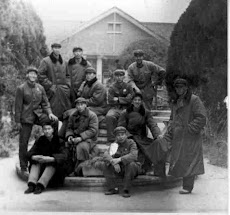


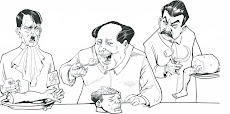
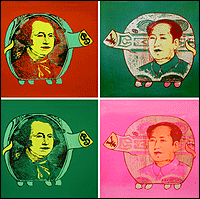
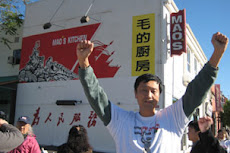


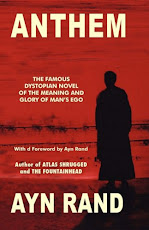










No comments:
Post a Comment